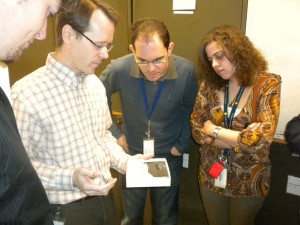One Bad Day in the Cambrian Yields Great Day for NMNH Fellows
In what could be described as the result of a very bad day about half a billion years ago, the fossils of the Burgess Shale provide a glimpse into early life on Earth, and served as the fodder for a Fellows collections tour.
Smithsonian Fellows are here to conduct their research, generally their own independent study, and our Fellows are an ambitions lot, often planning to accomplish some 5 years worth of research during a mere 2 year fellowship appointment. The long-time standing joke, yet seemingly accurate mind set, comes from a fellows answer to registration schedule: “Will you be here full time, 40 hours . . “ and their reply of “Oh yes, 40 hours per day, easily, at least!” Thus, it’s not often that our Fellows break away from their research to engage in events and activities, well, unless it’s an opportunity to see the Burges Shale collection.
First discovered in 1909 by Charles D. Walcott, then Secretary of the Smithsonian, the Burgess Shale fossils take their name from the Burgess Shale rock formation, named by Walcott after nearby Mount Burgess in the Canadian Rockies. The collection is particularly intriguing because appears to be a snapshot of life in the Cambrian; the result of an underwater avalanche of fine mud that preserved the entire ecosystem, including organism’s soft parts, in exceptionally fine detail.
The NMNH currently houses over 65,000 specimens from the Burgess Shale formation including an assortment of strange creatures, some of which represent early ancestors to modern groups, such as Pikaia gracilens, considered the earliest know representative of what would become the cordates – that’s us!
So did the Fellows enjoy their visit with the Burgess Shale? Here’s what some had to say:
“All students of biology and Earth history learn about the Burgess Shale because of its importance to understanding the early evolution of life on Earth. In addition to including many early representatives of animals alive today, it also includes a plethora of bizarre forms that have intrigued biologists and non-biologists alike. Until going on the tour, I was not aware that the Burgess Shale fossil collection at NMNH is the largest in the world. Being able to go behind the scenes to see the fossils up close and in person was a real treat, providing me with a much greater appreciation for the collection and the scientists who have worked with it.” - Michael Branstetter, NMNH Peter Buck Fellow.







